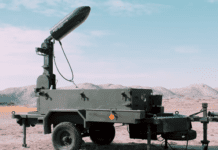This post is also available in:
 עברית (Hebrew)
עברית (Hebrew)
Defense Advanced Research Projects Agency (DARPA) signed a contract with Raytheon to create an airborne “wireless internet for energy” called the Persistent Optical Wireless Energy Relay program, POWER for short. The system will be used to deliver energy to US military assets in warzones and other contested environments.
According to Interesting Engineering, Raytheon’s plan is to develop the airborne relay design to create “webs” that will harvest, transmit, and redirect optical beams to transmit energy from ground sources to high altitudes. This will allow precise and long-ranged operation of unmanned systems and sensors. This is meant to enable the military to harvest energy while reducing its dependence on fuel.
Colin Whelan, president of Advanced Technology at Raytheon, said: “Energy is essential in the modern battlespace, and it is critical to achieving military objectives. When operating in contested environments, energy may not always be available or abundant, making the need to generate, store, and re-distribute it vital. This technology seeks to enable our military to generate power where it is safe and efficient to do so and easily distribute it to other platforms.”
POWER will make it possible to transfer energy to a target in the air, which could then remain in the air for as long as it needs with constant battery charging from a distance. By deploying power-relaying platforms in the sky, the POWER system will create an “energy web” that can be used by military logisticians to direct energy to the most crucial locations.
This “energy web” will be a supply line in the sky, providing robots on land, air, or sea with unlimited energy or redirecting the energy to other strategic locations as needed.
POWER program manager in DARPA’s Tactical Technology Office Colonel Paul Calhoun explains: “This is the internet for energy, harnessing resilient, multipath networks to flow energy from abundant sources to energy-starved consumers. The military faces particularly acute energy challenges, which are driving this innovation. We often must operate far from established energy infrastructure and rely on liquid fuels that require precarious supply lines.”
Nevertheless, like any other technological advancement, POWER has its limitations. For example, the web will come with the cost of a significant energy loss due to the conversion between electricity to light and back to electricity.
Despite this, DARPA seems to be optimistic about the technology for military purposes and civilian use in decentralized power, expressing their belief that the next energy revolution will be enabled by the wireless energy web. Calhoun claims that it will “dramatically compress transport timelines and resiliently provide distributed energy to consumers in air, on land, on the sea, undersea, and in space.”

























